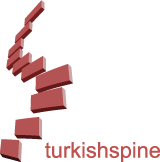ABSTRACT
Objective:
There is almost no controversy about the conservative treatment of patients with fractures with a Thoracolumbar injury classification and severity score (TLICS) of 1-3. External thoracolumbosacral orthosis is the recommended method. However, it is still controversial to support the TLICS with radiological parameters. The aim of this study was to evaluate the correlation between TLICS scores of 1-3 and clinical and radiological results of patients with stable thoracolumbar and lumbar vertebrae fractures, who were followed up conservatively.
Materials and Methods:
This retrospective study included patients diagnosed as having TLICS 1 to 3 thoracolumbar or lumbar vertebrae fractures who were followed up conservatively. Data were gained from the patient files. Outcome measures and classification parameters used were; visual analogue scale (VAS) and Turkish version of Oswestry disability index (ODI). The radiological parameters were measured. The recovery rates of all patients were evaluated, and correlation between clinical and radiological outcomes of the patients and TLICS scores was analyzed.
Results:
The mean duration of hospitalization and time to return to work were 1.61 and 126 days, respectively. Both VAS and ODI values steadily decreased over time. However, local kyphotic angle (LKA) and vertebra height loss (VHL) percentage values increased over time. TLICS did not correlate with the time to return to work. However, LKA at admission and VHL percentage at admission correlated significantly with the time to return to work.
Conclusion:
The TLICS classification seems to be effective in decision making in the conservative treatment of thoracolumbar and lumbar vertebral fractures, but it would be noteworthy to take into account the clinical and radiological parameters in this classification to predict the treatment period and time to return to work.
INTRODUCTION
The conservative approach is the generally accepted treatment method in stable thoracolumbar and lumbar fractures(1-5). In this sense, an external thoracolumbosacral orthosis (TLSO) is recommended according to the level of injury(1,2). Herewith, in recent years, the thoracolumbar injury classification and severity score (TLICS) have been frequently used to determine management(2,4,6-8) (Table 1). There is almost no controversy about the conservative treatment of TLICS 1-3 fractures and operative treatment of TLICS ≥5 fractures, whereas TLICS 4 is controversial(2,8-11). However, the lack of predicting radiological progress and time to return to work are the main challenges of TLICS. For instance, the progressive kyphotic deformity was shown in comminuted burst fractures with a TLICS score of 2 treated non-operatively(12). Moreover, it has been suggested that worsening radiographic findings are associated with an increase in the incidence of permanent pain(4,11). There are also studies showing no correlation between the local kyphosis angle (LKA) and vertebral height loss (VHL) and clinical results. From this point of view, it was claimed that radiological parameters should be excluded from the TLICS(13). However, it is still controversial to support the TLICS with radiological parameters(8,10,13,14). Based on our experience, although TLICS is an effective method to choose the treatment method, it is still insufficient in predicting radiological changes and returning to work. Therefore, we aimed to evaluate the correlation between TLICS scores (1 to 3) and clinical and radiological results of patients with stable thoracolumbar and lumbar vertebrae fractures, who were followed up conservatively.
MATERIALS AND METHODS
Study Design and Participants
This retrospective study was conducted after the approval of the Clinical Research Ethics Committee. Between January 2013 and December 2017, the patients diagnosed with TLICS 1 to 3 thoracolumbar or lumbar vertebrae fractures, and who followed up conservatively in a tertiary hospital were enrolled. Inclusion criteria were; traumatic thoracolumbar and lumbar fractures (compression and burst) between T11-L5, only score of TLICS 1 to 3, without neurologic deficit, age at 18 to 65 years, within 24 hours of presentation and a minimum 24 months of follow-up period. Exclusion criteria were other TLICS scores such as ≥4, patients with follow-up period of less than 24 months, pregnancy, having pathological fractures (cancer, infection) or osteoporotic fractures, previous history of spine surgery, and any missing data regarding the fracture. The patients were divided into three groups according to the scores obtained in TLICS classification. The recovery rates of all patients were evaluated, and the correlation between clinical and radiological outcomes of the patients and TLICS scores were compared. Informed consent was obtained from the patients.
Treatment Method
Patients were hospitalized for observation a minimum of 24 hours after diagnosis. Bed rest in a supine position, analgesic, and subcutaneous anticoagulant (enoxaparin sodium 40 mg=4000 anti-Xa IU) therapy was administered. All patients were encouraged to be mobilized with a TLSO (Biofix® BA-287) one day after the hospitalization. After discharge, the patients after were advised to comply with bed rest (at nights in supine position), to use TLSO (in sitting and standing position), anticoagulant therapy, and analgesic drugs. All patients were examined clinically with 2 weeks of intervals and radiologically 4 weeks of intervals, for 12 weeks. Thereafter, the follow-up was continued three months of intervals for 24 months.
Data Collection and Radiographic Evaluation
The data were obtained from the medical records of the patients. Clinical and demographic features (age, gender, level of fracture, and return to work) were noted. All patients had images of the two-plan radiograph, computed tomography scan, and magnetic resonance imaging on admission. Angular measurements were performed on the lateral spine radiographs at the first admission and at the final follow-up. LKA was measured as the angle from the superior end-plate to the inferior end-plate(13). Normalized VHL was calculated as a percentage of the height loss normalized to the average of the vertebral bodies above and below the injured segment(13). Radiographic evaluations were performed by a blinded senior spine surgeon.
Outcome Measures
The primary functional outcome measure was the oswestry disability index (ODI) that was validated for the Turkish population(15). The ODI is a functional, disease-specific instrument comprising ten questions on limitations in the activities of daily living, caused by low back pain. Each question is scored 0 to 5. The ODI score is multiplied by two to acquire the percentage. The total score ranges 0 (best health state) to 100 (worst health state).
Secondary outcome measures included back pain visual analogue scale (VAS)(16) score, and time for the return to work. Records of VAS scores for back pain were collected and compared between the groups.VAS is a well-known, validated instrument to let patients score their daily pain. We used a 0 to 10 scale as scored 0=no pain and 10=unbearable pain. Time for a return to work was determined from self-reported at last follow-up time.
Statistical Analysis
SPSS software package program (SPSS Inc., version 16, Chicago, IL, USA) was used for statistical analysis. Descriptive data were given as mean, standard deviation, median, number, or percentage. Baseline and after-surgery data were compared using the Paired t-test or Wilcoxon signed-rank test. Pearson correlation analyses were performed for the correlation analyses. A value of p<0.05 was accepted as statistically significant. In the calculation of the post hoc sample size, the power of the study with 0.05 alpha value was found over 80%. The standard effect size for quantitative data was set at 0.81 %, and the power of the study was 99%.
RESULTS
This study included a total of 153 patients (102 males, 51 females) with a mean age of 44.50±13.3 years (ranges 18 to 65 years). Clinical and demographic properties of the patients are summarized in Table 2. Seventy-five patients (49.0%), 71 patients (46.4%), and 7 patients (4.6%) patients were scored as TLICS 1, 2, and 3, respectively. The mean duration of hospitalization and time for the return to work was 1.61 and 126 days, respectively. The mean VAS score at admission was 8.29±1.1, and the mean ODI was 21.38±8.1 at the 3rd month. Both VAS and ODI values steadily decreased over time (Figure 1). However, LKA and VHL values increased over time (Figure 2). The mean LKA increased from 26.75±6.7 to 30.80±6.9 (p<0.001). The mean VHL increased from 39.84±8.7 to 47.81±8.6. Correlation analyses are shown in Table 3. TLICS did not correlate with the time for the return to work (r=0.124, p=0.127). However, LKA at admission (r=0.427, p<0.001) and VHL at admission (r=0.254, p=0.002) correlated significantly with the time for the return to work. As the LKA or VHL increased, time for the return to work did prolong. Similarly, the VAS scores (r=0.288, p<0.001) and ODI values (r=0.167, p=0.039) significantly correlated with the time for the return to work.
DISCUSSION
The purpose of this study was to evaluate the relationship between TLICS scores (1 to 3) and clinical and radiological outcomes of patients with stable thoracolumbar and lumbar vertebrae fractures and treated conservatively. Three main findings emerged from this study. First, the conservative treatment showed satisfactory outcomes. ODI and VAS scores values steadily decreased over time and significantly correlated with the time for the return to work. Second, both LKA and VHL values increased over time and were associated with prolonged time for the return to work. Third, TLICS values did not predict the return to work and radiological or clinical outcomes.
The generally accepted management in stable thoracolumbar and lumbar fractures is conservative treatment, and an external TLSO is recommended according to the level of injury(1-5). There has been debate about the effectiveness of bracing in stable fractures(17). Bailey et al.(18) concluded that using brace in burst fractures with neurologically stable patients did not affect the outcome regarding pain control and function. Therefore, TLSO was routinely used for conservative treatment in the present study. According to our results, all patients had improved satisfaction in terms of pain and disability. Herein, we would like to highlight once again that conservative treatment, including TLSO, bed rest, and analgesics, seems to be effective in TLICS 1-3 patients. Our findings were consistent with the literature as regards the effectiveness(1,3-5). However, the TLICS did not predict a return to work. Thus, compatible with the literature (2,9), both ODI and VAS scores correlated with earlier return to work.
The time for the return to work is a significant determinant of the efficacy of the management, and this issue was previously studied in several studies in the literature. Wood et al.(19), in a prospective and randomized trial, enrolled 47 patients (24 surgery vs. 23 orthoses) with thoracolumbar burst fractures without neurological deficit. At the final follow-up (minimum two years), there were no statistical differences in terms of return to work between the two groups, with a tendency to better results in the conservative group. Shamji et al.(20) compared bracing with no-bracing groups in their randomized controlled trial whereby there was no difference in terms of LKA and VHL progression or clinical outcomes during the sixth months of the follow-up period. However, the effectiveness of orthosis was investigated and was reported to be a safe method with acceptable functional and radiographic results in the treatment of thoracolumbar fractures(1). Studies also showed that chronic back pain and VHL were associated with patients with thoracolumbar vertebrae fractures(21). In our study, although TLICS 1 to 3 patients improved clinically over time, their radiological parameters, i.e., LKA and VHL, worsened. Besides, the radiological parameters significantly correlated with delayed return to work. Previous reports also reported that TLICS classification had limitations to predict clinical and radiological outcomes in patients who needed surgery for permanent pain or progressive deformity (TLICS score less than 4 points)(3, 6,10,22).
The retrospective design is the main limitation. Although the follow-up period (24th months) is acceptable compared with the previous studies, it could be longer. In addition, the absence of a control group or a surgery group is another limitation of this study.
CONCLUSION
According to the data revealed by the present study, TLICS classification seems to be effective on decision making in the conservative treatment of thoracolumbar and lumbar vertebral fractures, but it would be noteworthy to take into account the clinical and radiological parameters in this classification to predict the treatment period and return to work. Further studies on this matter in prospective designs are awaited.



